Saturday, October 17 Last weekend we took Kosmos out for a short jaunt just to give her some exercise. This weekend Eric intended to work on some boat chores, but when he got up this morning, he just didn’t feel like it. It was an absolutely beautiful day, and he wanted to go and play. We decided to go over to the Maritime Museum. Christi has never been there and Eric hasn’t been there in years. The main reason we wanted to go there is to check out the Russian submarine they have on display. We are dreaming of owning our own submarine someday.
When we got to the museum we were delighted to see that they have recently added another vessel to their collection, a submarine! It is the USS Dolphin, the only operational diesel-electric submarine in the US Navy’s fleet. The USS Dolphin is 165 feet long, 18 feet wide and has an 18 foot draft. She displaces 800 tons. Her engine is a Detroit 12V71 diesel: 1650-hp and she has only one shaft. She is fitted with “246 Module VRLA Battery”. Under water, she can do 10 knots for a short duration, for sustained time under water she can do 4 knots.
She was first commissioned in 1968 and decommissioned in 2007. Thanks to a special pressurized hull, she is the world’s deepest diving submarine. How deep she has actually gone is still classified information, all the navy will disclose is more than 3,000 feet. In 1969, the USS Dolphin launched a torpedo from the deepest depth ever recorded. Most of her career she was used for research, aiding the navy in the development of submarine-ship communications, Extremely Low Frequency antennas, sonar systems, and ocean floor surveys. Later in her career, she was also loaned out to civilian organizations for special oceanographic studies. Most of its life in was in service in or around San Diego. In 2002, she almost sank. The sub was saved by the brave crew onboard and nearby military vessels that came the rescue. She was seriously damaged and the navy spent $50 million dollars repairing and upgrading her. The retrofit was completed in the summer of 2005 and she went back to work. A year later the navy decided to retire her and a few months later she was pulled from service.
Of course, we made a beeline for USS The Dolphin. The tall hatch that sticks up used to be the only entrance/exit onto the sub. As you can see, the hatch is quite small and steep. When equipment needed to be loaded/unloaded, it had to be disassembled into small bits and reassembled on the other side. The hatch was also the only source of fresh air. There was no snorkel onboard, so when they dove under there was no fresh air source. The museum built a special entrance that is easier to get in/out of. You can see the walkway to the door to Eric’s left.
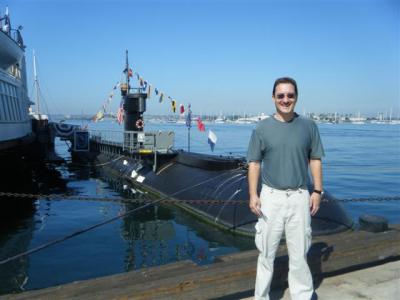
When we walked in, we were surprised by the layout. She has no bulkheads (load bearing walls), and you could almost see down the length of the boat from the entrance. There were a few areas off to the right that were partitioned off with curtains or non-load bearing walls, but for the most part, it was a long, skinny open space. We checked out the command station and examined the few electronics that have been left. We peeped into the periscope. We checked out the living quarters, the kitchen/dining area, berths, bathrooms, etc. We could only stay on the main level, we weren’t allowed to go to the engine room on the lower level. Since it was a navy research ship, the décor is certainly austere””plain gray metal walls with uninteresting but functional equipment and furnishings. But it looks like it can meet all a person’s needs. After inspecting it, we decided that with a little remodeling, we could live aboard. Now we are yearning more than ever for a sub!
Next we went to see the Russian sub. It doesn’t have a name. Apparently, the Russians changed the name often to confuse foreign spies and none of the names has stuck. It is a b-39 long range Foxtrot Class attack sub capable of cruising 20,000 miles on 256 tons of diesel. It is also diesel-electric, with three diesel engines that each generate 2,000 horsepower, 448 two volt batteries (one engine’s sole purpose was to keep the batteries charged), and three electric motors, one 2700 hp and the other two 1350 hp. She also has a 180 hp “creep” electric motor. The “creep” motor only does 2 3 knots, but makes no noise and can run for three days without recharging, allowing the sub to escape detection from enemy forces. She has three propellers and can do 16 knots on the surface and 15 knots underwater. She is 299.5 feet long and displaces 2,475 tons when submerged.
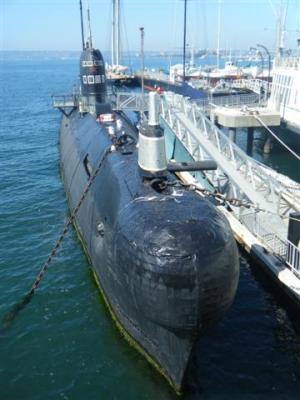
She was commissioned in 1974 and is and is one of the finest non-nuclear submarines ever built. She can dive to 985 feet, though she typically stayed about 750 feet. When she was in service, she was loaded with assorted weapons, including 22 torpedoes (some nuclear tipped), mines and noisemakers. She never used any weapons in battle, and only fired one torpedo a year for training. For most of her career, she followed around American aircraft carrier battle groups to keep an eye on them. She also did some coastal patrolling in Asia, the Americas, the North pacific and the Arctic Ocean. In 1994, she was decommissioned and in 1995 she was sold to a private corporation in Canada to be used as an exhibit vessel. At first she was displayed in Seattle and in 2005 was moved to San Diego.
We walked up the ramp into the entrance and went inside. The inside of the USS Dolphin looked kind of like a regular ship sans walls, and was neat and orderly inside, with little clutter. But this sub looks like something straight out of the movies. It has low ceilings, bulkheads galore with very small hatches that are not exactly easy to walk through, and clutter everywhere.
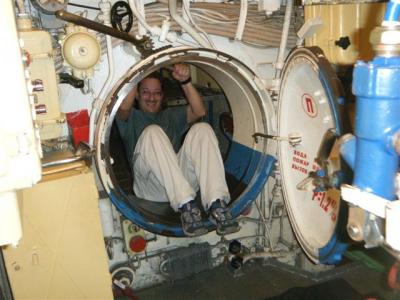
Of course, all the clutter is essential items, but with the small rooms, low ceilings and stuff galore, it is not a good place for someone who is claustrophobic. The sub’s helm is located with all kinds of equipment and gadgets that all look very 1960’s.
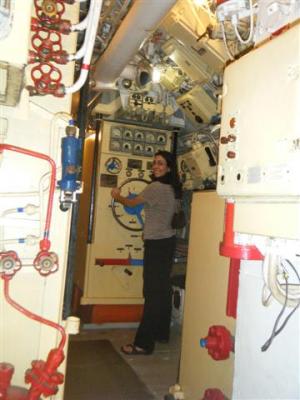
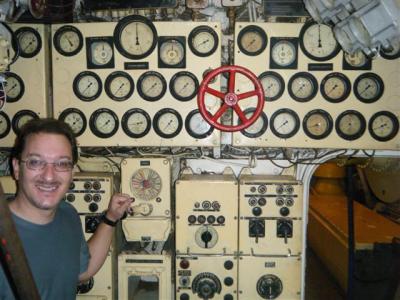
The sub is equipped with torpedo launching tubes at both ends.
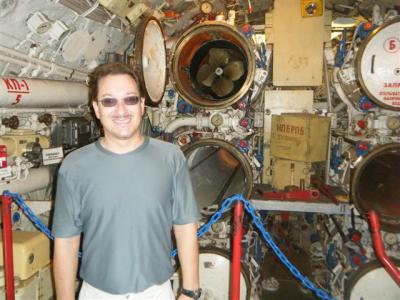
Life on board sounded awful. She had a crew of 78, with only three toilets and showers. The enlisted guys had to share bunks with people on opposite watch schedules from them. One freshwater shower was allowed per week. Since laundry wasn’t happening, they simply threw away dirty clothes and sheets.
As we walked around, we noticed some holes in the hull. The museum is leasing it and the lease is up next year. They are going to give it back to the owners because the museum doesn’t want to pay for the maintenance anymore. The problem is the owners don’t want it back, so the owners are thinking about sinking it outside San Diego.
Next we went to see the Steam Yacht Medea, built in 1904 and one of the last of this type of boat in existence. She is 130 feet long, 17 feet wide, and has a 9 foot draft. She displaces 137 tons and has a 254 hp vertical 2 cylinder steam engine. The steam boiler creates 120 pounds of pressure. It was originally coal fired, but in 1964 was changed to oil. She does 6 knots.
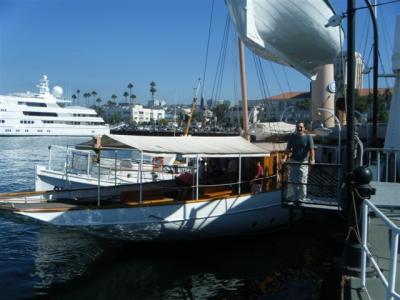
She was originally built for private use by a wealthy Scottish man. In 1917 she was sold to the French navy and armed to be used as an anti-submarine vessel. In World War II, she served again, this time in the British and Norwegian navies. In 1971 it was sold to a private party, who partially restored it to its former private yacht glory. In 1973, he donated it to the maritime museum. The yacht is still regularly taken out for cruises around the bay.
We were disappointed to see that the vast majority of the boat is closed to visitors. We only got to see the back deck, front deck, kitchen and dining area. It is beautifully restored and has that classic, old-time opulent feel to it.
To be continued…
